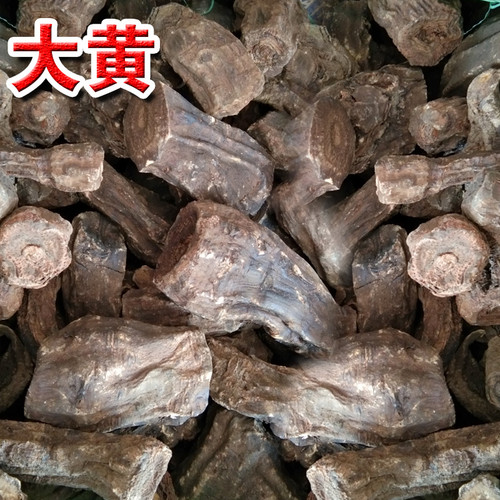Product Overview
Parts used: Dried root and rhizome
TCM category: Purgative herbs that drain downward
TCM nature: Cold
TCM taste(s): Bitter
Meridian affinity: Spleen Stomach Large intestine Liver Pericardium
Scientific name: Rheum palmatum, Rheum tanguticum or Rheum officinale
Use of rhubarb (Da Huang) in TCM
Please note that you should never self-prescribe TCM ingredients. A TCM ingredient is almost never eaten on its own but as part of a formula containing several ingredients that act together. Please consult a professional TCM practitionner, they will be best able to guide you.
Preparation: Remove the stems and leaves from the rhizome and root, scrape off the rough skin and top buds, slice and dry.
Dosage: 3 - 12 grams
Main actions according to TCM*: Drains Excess Heat and eliminates Dampness, especially when in the Sunlight Yang stage. Cools the Blood and stops bleeding. Invigorates Blood, breaks up Stasis and relieves pain. Clears Heat and toxins from Excess. Applied topically for Hot sores and Blood Stasis.
Primary conditions or symptoms for which rhubarb may be prescribed by TCM doctors*: Constipation Fever Jaundice Dysentery Hematemesis Nosebleed Conjunctivitis Appendicitis Abdominal pain Sores Abcesses Amenorrhea traumatic bleeding Traumatic swelling Burns
Contraindications*: This herb should only be used where there is a definite condition of Heat and Dampness; Rhubarb should be used by nursing mothers with extreme caution.
Common TCM formulas in which rhubarb are used*:
For swollen glands combine rhubarb with maral roots (Lou Lu) and forsythia fruits (Lian Qiao).
For fullness and distension of the abdomen due to Heat accumulation combine rhubarb with goldthread rhizomes (Huang Lian).
For jaundice with flank pain combine rhubarb with virgate wormwood (Yin Chen) and cape jasmine fruits (Zhi Zi).
For intestinal abscesses combine rhubarb with mudan peony bark (Mu Dan Pi) and peach kernels (Tao Ren).
For intestinal abscesses combine rhubarb with wax gourd (Dong Gua) and mudan peony bark (Mu Dan Pi).
Key TCM concepts behind rhubarb (Da Huang)'s properties
In Traditional Chinese Medicine (TCM), rhubarb are plants that belong to the 'Purgative herbs that drain downward' category. The herbs in this category are those whose main purpose is to treat constipation. The fact they're 'purgative' means that they do so by removing excess Heat in the Intestines and/or Stomach. As such all herbs in this category are Cold in nature, in order to cool the Heat.
Furthermore rhubarb are plants that are Cold in nature. This means that rhubarb typically help people who have too much "heat" in their body. Balance between Yin and Yang is a key health concept in TCM. Those who have too much heat in their body are said to either have a Yang excess (because Yang is Hot in nature) or a Yin deficiency (Yin is Cold in Nature). Depending on your condition rhubarb can help restore a harmonious balance between Yin and Yang.
Rhubarb also taste Bitter. The so-called "five elements" theory in Chinese Medicine states that the taste of TCM ingredients is a key determinant of their action in the body. Bitter ingredients like rhubarb tend to have a cleansing action on the body by clearing heat, drying dampness and promoting elimination via urination or bowel movements.
The tastes of ingredients in TCM also determine what organs and meridians they target. As such rhubarb are thought to target the Spleen, the Stomach, the Large intestine, the Liver and the Pericardium. In TCM the Spleen assists with digestion, blood coagulation and fluid metabolism in the body. The Stomach on the other hand is responsible for receiving and ripening ingested food and fluids. It is also tasked with descending the digested elements downwards to the Small Intestine. The Large Intestine receives the "impure" parts of the digested food from the Small Intestine, absorbs the remaining fluids and excrete the remainder as feces. The Liver is often referred as the body's "general" because it is in charge of regulating the movements of Qi and body fluids. It also takes a leading role in balancing our emotions. The Pericardium is also called the "heart protector". It is the first line of defence for the Heart against external pathogenic influences.
Use of rhubarb (Da Huang) as food
Rhubarb are also eaten as food. It is used as an ingredient in dishes such as Rhubarb pie.









